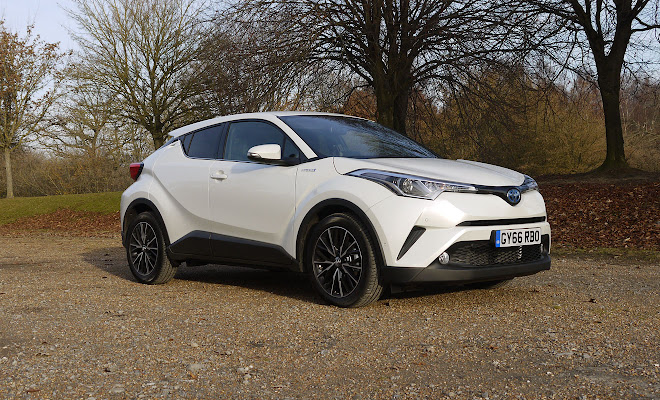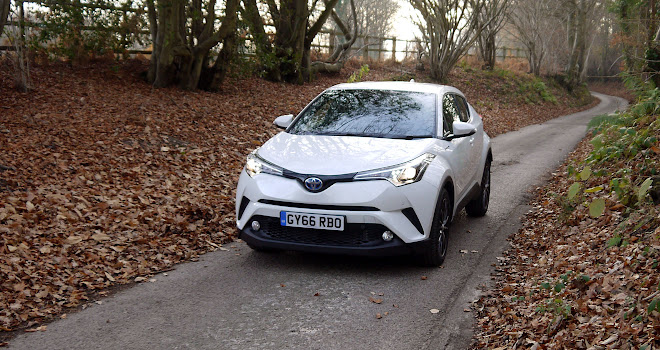
Rating: stars
Good: arresting design, surprising economy
Bad: cramped rear seats, dire over-the-shoulder vision
Price: from £23,595 – £30,135 as tested
Toyota has a history of putting its clever, economical Prius powertrain into alternative bodies. In the past the Prius has donated its petrol-electric innards to the smaller Auris Hybrid and plusher Lexus CT-200h. Now hybrid technology from the latest fourth-generation Prius has found its way into a high-riding five-door coupé body. Is the result good, bad or ugly?
Well, I for one don’t think it’s ugly. The C-HR’s busy design won’t be to everyone’s taste, but the creases, chops and folds of the bodywork are arresting and, in places, clever as well. They skilfully disguise quite a lengthy front overhang, for example.
The unusual design also makes it hard to judge how big the C-HR is. Up close, it’s taller, broader and more substantial than it seems in pictures.

Inside, the front cabin has clearly been designed to feel cosseting rather than spacious. Console controls and the high-set touchscreen lean in towards the driver, and there’s a broad central tunnel dividing the two front occupants.
You sit up high and the steering wheel is mounted rather low, even when hauled to the top of its travel. The result can feel a little like you’re twirling the wheel in your lap, though it’s not an uncomfortable posture. You can of course drop the seat to its lowest setting, but then you lose the high-riding viewpoint that is part of a crossover’s appeal.

Forward vision is first-class, with slim pillars and a low scuttle. Over-the-shoulder vision is dire, by contrast, pretty much as bad as driving a van. Arrive at an angled T-junction and you’ll find the C-HR’s swoopy glazing and bulky passenger seat conspire to block out most of the road to the left.
The shallow side windows and unusual rear door-handles help to create the C-HR’s coupé vibe. Note I don’t say hidden handles, because although they don’t match the front set the rear handles do still pop out like a pair of sore thumbs. This may be a good thing, however, given that in my experience a really stylishly hidden handle, as pioneered by the Alfa 156, means endlessly having to point out to confused passengers that there are doors they can use at the back.

Inside, the coupé styling means small side windows and a rear bench about as welcoming as a deep hole in the ground. Be warned: small children may vomit.
Other aspects of the C-HR interior are surprisingly conventional. There’s a modern electronic handbrake, which I found preferable to the Prius’s US-style parking pedal. A conventional auto gearstick also appears, rather than the Prius’s spring-loaded gear-selecting plastic mushroom. And the C-HR’s instruments are presented as a cluster of analogue dials behind the wheel, where the Prius offers up a centre-mounted strip of computer-game graphics.

One notable omission is a driving mode controller. The Prius provides a big button to switch between Normal, Eco and Sport settings, but there’s no equivalent in the C-HR. It is still possible to choose among the three modes, though it requires some patient prodding through the menus using the steering-wheel buttons.
In the Prius I found Eco Mode too hesitant to bother with, but throttle settings must have been tweaked for the C-HR because its Eco Mode proved perfectly tolerable. Perhaps I was in less of a hurry. Normal Mode feels more eager, of course, while Sport Mode is more frantic still, especially on the ears.
It’s a shame that the mode selector has been buried in the menus – it means you can’t potter around economically but quickly flip into Sport Mode for a spot of instant overtaking or to be sure of launching safely from a busy junction. In a dual-clutch VW Golf, for example, you can toggle between Eco and Sport simply by tugging on the gearstick, which is a brilliant way of combining thrift and shift.

If you can cope with Eco Mode it does deliver a big boost to the C-HR’s economy. For me, it saved about 10mpg, with the car leaping up from low-50s to low-60s miles per gallon. I also kept the climate control in its own leisurely Eco setting, though I can’t vouch for how well that might work on a sunny summer’s day.
Of course ultimate economy is not the C-HR’s goal. If you wanted to eke out every drop of petrol, you wouldn’t choose such a tall and broad shape or fit big 18-inch alloys shod with 50-profile 225-wide tyres. You would, in short, buy a Prius on 15-inch wheels.
Even with its inherent styling handicaps, the C-HR Hybrid still manages to achieve an official CO2 rating as low as 86g/km – not as keen as the Prius’s 70g/km, and not good enough for exemption from the London Congestion Charge, but not bad at all for this style of car. Kia’s hybrid softroader, the Niro, is rated slightly worse at 88g/km, for example.

On the move the C-HR Hybrid behaves as expected – like a Prius in disguise. Setting off and cruising at a steady speed are often accomplished in silence, using the hybrid electric motor. When the petrol engine joins in it does so seamlessly and smoothly – but generally not very quietly.
The engine will often seem to be revving away unnecessarily keenly. This is deliberate and is part of Toyota’s strategy for saving fuel. A lightly loaded petrol engine is not very efficient, whereas a harder worked engine makes better use of all the fuel it sucks up. Hence Toyota has set up its engine to either be switched off or working reasonably hard.
At high road speeds or when accelerating briskly the engine gets a sufficient workout simply from propelling the car, but at modest speeds or under gentle acceleration Toyota’s hybrid system throws on the extra load of charging the battery. Once the battery has accumulated a bit of charge, the engine switches off. As a result, driving around town tends to feature silent wafting punctuated by surprisingly loud charging sessions.
Once you understand what it’s doing, the on-off nature of the noise becomes less annoying. It is, after all, saving you money.

The engine itself is a highly efficient 1.8-litre Atkinson-cycle petrol engine that produces up to 97bhp and 142Nm of torque. It is aided by a 53kW (71bhp) electric motor yielding another 163Nm of torque. Overall system output peaks at 121bhp (90kW). Hybrid energy storage is handled by a modest 1.31kWh nickel-metal hydride battery mounted under the back seats.
The C-HR doesn’t plug in – at least for now. Given that a new Prius Plug-in is on the way, it’s reasonable to expect a mains-charged C-HR in due course.
Odd noises aside, the C-HR is a generally pleasant place to travel. The tall suspension proved capable of soothing away all but the worst of surfaces, and the fairly light steering suits the car’s relaxed demeanour. It never feels very sporty, but neither is it at sea around corners.

The large, bright touchscreen is particularly well positioned for satnav guidance and responded promptly to prods. Linking up my phone via Bluetooth was accomplished painlessly.
Safety features such as speed-sign recognition worked seamlessly, with none of the mistakes made when I tested the Prius (the latter kept spotting speed limits on the backs of foreign lorries, informing me of a 110mph limit at one point).
Pre-option prices for the hybrid version of the C-HR start at £23,595 for the entry-level Icon trim level, £26,495 for the mid-range Excel and £27,995 for the top Dynamic edition. Very similar, in fact, to the Prius.
The outlay underscores the nature of the proposition. The C-HR is designed to provide most of the benefits of a Prius in a much more stylish package designed to appeal to people who would never consider a Prius. I think that’s a very welcome development.









